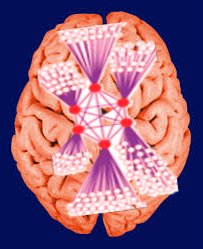Recent scientific studies on meditation demonstrated that rich club brain network have a key role to play in making global communication and information integration during meditation. The human brain is a complex network of interlinked regions. Scientific studies on meditation demonstrated that the anatomical network of the human brain shows a “rich-club” organization. The aim of this article is to highlight the neuroscience of meditation with the dynamic rich-club network structures within the brain which are involved during various types of meditation.
What is Rich Club?
Growing body of research evidence suggests that a network of highly interlinked brain regions exists that could prove essential in facilitating higher-order tasks like meditation. This collection of highly connected hubs has been dubbed as “rich club” network. A hub is a highly connected node with high centrality. Brain networks are now assumed to be energy efficient local hubs. They have some long-range connections to other hubs. Recent research shows [1,2,3] that in the normal brain there are many local hubs that are highly connected together—such a brain network is called a “rich club”. A rich club implies that a group of nodes, or hubs (center of neuronal cell bodies) are very highly connected—that is, more heavily interconnected with each other than expected by chance. These highly locally connected hubs are, also, connected long range with other hubs. The rich club members can easily influence large numbers of other nodes, it’s possible to manipulate the entire brain network, simply by targeting the small number of rich club members.
Meditation and Rich Club Members
 This study aims to map out both the subcortical and neocortical hubs of the brain and examine their mutual relationship, particularly their structural linkages during meditation. The effect of meditation on rich-club hubs are studied. Continuous coactivation matrix was used to build a weighted graph to characterize network topology. This allows the researchers to map the theoretical frame-work of information flow between regions during meditation. This also provides the deeper insights into the self-organizational dynamic properties of neuronal cell during meditation and thereby provides better understanding about the complexity of brain networks. During different types of meditation the researchers observed that six-hubs play a key role in global information integration between different parts of the brain network.
This study aims to map out both the subcortical and neocortical hubs of the brain and examine their mutual relationship, particularly their structural linkages during meditation. The effect of meditation on rich-club hubs are studied. Continuous coactivation matrix was used to build a weighted graph to characterize network topology. This allows the researchers to map the theoretical frame-work of information flow between regions during meditation. This also provides the deeper insights into the self-organizational dynamic properties of neuronal cell during meditation and thereby provides better understanding about the complexity of brain networks. During different types of meditation the researchers observed that six-hubs play a key role in global information integration between different parts of the brain network.
Conclusion
Rich clubs have been discovered in many interconnected systems, including the Internet, social networks and flight patterns. But what happens to brain’s rich club during meditation? Although the answer is still unclear, preliminary evidence suggests a connection between six rich club members are very prominent. There is thus the beginning of a definite neuroscience of meditation with the highlighting of a dynamic network structures within the brain which are involved during various types of meditation.
References:
1. Neuronal networks: In the rich club, by Katherine Whalley, Nature Reviews Neuroscience 13, 3 (January 2012)
2. Dwelling quietly in the rich club: brain network determinants of slow cortical fluctuations by Leonardo L. Gollo et al. Philosophical Transactions of the Royal Society , Published on 30 March 2015
3. Rich-Club Organization of the Human Connectome, by Martijn P. van den Heuvel, The Journal of Neuroscience, 2 November 2011, 31(44): 15775-15786
4. The neuroscience of mindfulness meditation, by Yi-Yuan Tang et al. Nature Reviews Neuroscience16,213–225
5. Frequency-specific network topologies in the resting human brain, Front. Hum. Neurosci., 22 December 2014